#which if they were indigenous would make them two-spirit which is such an underrepresented identity & would be a HUGE win for diversity
Explore tagged Tumblr posts
Text
i’ve really been hoping that g3 Venus would be Indigenous bc venus flytraps the actual plant are exclusively indigenous to coastal areas in north & south carolina usa so it would make sense & be cool to see venus be part of an Indigenous nation in the same area. it’s looking like in this gen she’s going to be black/black coded but afroindigenous ppl exist so maybe i’m still holding out hope lmao
#if anyone says that they must b scottish/irish bc of their surname y’all know that’s bullshit 😐#a lot of native americans have european surnames due to colonization so they can have an ‘mc’ name & still b native#also venus flytraps are simultaneously male & female meaning venus could very much be an intersex & nonbinary character#which if they were indigenous would make them two-spirit which is such an underrepresented identity & would be a HUGE win for diversity#idk i respect their decisions but to me it feels pretty obvious w a quick google search on the plant to realize that they should b native#like it just makes the most sense? so ig i’m gonna feel p disappointed if venus isn’t indigenous in g3#ig it doesn’t rlly matter#also they turn black in their dormant period so they should become goth in the winter😭😭#i like venus’ leaked design so far but i know damn well she will b impossible to get😭😭#monster high#mh#monster high dolls#monster high gen 1#monster high gen 3#venus mcflytrap
60 notes
·
View notes
Text
How Lovecraft Country Silences Yahima
https://ift.tt/eA8V8J
This Lovecraft Country review contains spoilers.
Lovecraft Country is a rapturously violent dramatic horror series where pain and death are par for the course. And while the show delights in depicting wickedness, the violence always feels purposeful. Even with that in mind, however, last week’s episode, “A History of Violence,” makes the disappointing choice to unceremoniously kill Yahima, an indigenous, gender-variant character.
After an Indiana Jones-esque journey through a booby-trapped tunnel Tic, Leti, and Montrose enter Titus Braithwhite’s underwater vault, a room full of the remains of indigenous people —made apparent by their regalia— and a corpse holding Titus’ pages from the Book of Adam. When Montrose attempts to grasp the pages, the corpse reanimates. The camera lingers on the naked figure, and Montrose asks “what are you?” The recently-reanimated individual introduces themselves as Yahima, “Woman—and man, two-spirit. Neither. Both. All”
Yahima is an Arawak, the indigenous ancestors of modern-day Taino people. They’re from Guyana —”the land of many waters”— a country in the Carribean region of South America. They are Two-Spirit, which is an exclusive Indigenous-American umbrella term —like LGBTQ— for a unique gender identity that encompasses gay, lesbian, nonbinary, intersex, transgender, and other queer or gender-nonconforming identities. (Two-spirit as a term was coined in 1990, so Yahima would not use it as an identifier.) Physically, Yahima presents as intersex, a person who is born with a combination of male and female biological traits. They may also read as trans. As such they represent both the native community and the gender-variant one.
European colonization and Christian indoctrination reconceptualized the definitions and functions of gender and sex in indigenous communities in the Americas and around the world. Still, many native tribes recognize a Third Gender, while some acknowledge as many as five genders or more. The Navajo, for example, have four distinct genders. More traditional tribes reject the term Two-Spirit as it reinforces the binary of “male” and “female” which is thought to be a Western construct. Gender and sex are complex concepts, but the Two-Spirit identity and the spiritual/gender identities it encompasses, is rich with native cultural significance.
The inclusion of an indigenous character and an intersex character in a high profile show is momentous because those identities are grossly underrepresented. It should be noted that the actress portraying Yahima, Monique Candelaria, is a cisgender woman, who uses she/her pronouns, and describes herself as ”ethnically mixed with Spanish, French, Aztec and Apache Indian.” Characters who occupy very specific cultural identities should be played by performers who share those identities, especially when there are so few opportunities for gender-nonconforming roles. But the inclusion itself is creditable.
Tic is magically able to understand Yahima —who speaks Lokono, an Arawak language— and we learn Yahima’s story through Tic’s interpretation, instead of directly from Yahima through use of subtitles. We learn that Titus Braithwhite came to their land looking for people to translate the Book of Adam. Yahima recognized the symbols from the caves of Alomun Kundi, and with no reason to distrust Titus, agreed to decipher the pages. When they saw Titus for what he was, they refused to continue their translation. Titus murdered their entire family, then imprisoned them in a grave. Yahima used the pages to protect themself.
Yahima tells Tic,“You are not guilty of your forefather’s sins, But I do not know your spirit. I will not help you.” So Montrose grabs for the scroll, again, this time triggering the vault to flood. Montrose and Leti make way toward the elevator, but Tic pauses to save Yahima, even amidst Yahima’s refusal to help decipher the pages. As the elevator ascends, Yahima attempts to speak, but instead unleashes a piercing scream. They are made into a siren, so they cannot speak if they escape Titus’ vault, which effectively silences them. Later, after Montrose has failed to sabotage Tic by losing the scroll, he takes away Tic’s only chance to decipher the pages by slitting Yahima’s throat. This is an egregious act of violence on an indigenous, gender-variant person by a Black, queer-coded man.
In the episode we see Titus’ literal history of violence in both his public trophies of conquest on display at the museum, and his private collection of stolen legacy locked away in his vault. The episode speaks to the lasting harm of colonialism and the specific violence visited upon the indigenous communities whose land, resources, people, and cultures were systematically stripped from them. Through Yahima, that violence could be confronted in a way that empowers indigenous and/or gender-variant viewers, the way Black viewers are empowered when Tic collapses a house on a group of racist white men. Yahima has survived for centuries, and may well be able to survive this. But unless and until that possibility is realized, we have to sit with the gratuitous murder of a potentially groudbreaking native, gender-variant character.
cnx.cmd.push(function() { cnx({ playerId: "106e33c0-3911-473c-b599-b1426db57530", }).render("0270c398a82f44f49c23c16122516796"); });
Gender nonconforming people —and intersex, trans, androgynous, two-spirit people— are some of the most vulnerable of the population, especially if they are BIPOC. Depictions of gender variant people in entertainment media often otherizes them, and their stories frequently comprise of violence, and end in death. Introducing Yahima only to immediately kill them off in a brutal, callous way perpetuates this tired and harmful trope and normalizes violence against these groups. It also deprives underrepresented people the ability to be reflected, and respected, in the stories they consume.
Lovecraft Country gives its Black characters the tools to fight their demons and their oppressors, and it works so well because it punches up. Black characters visiting the same violence on other marginalized folks that their oppressors visit on them is not empowerment. “For the master’s tools will never dismantle the master’s house.” — Audre Lorde
The post How Lovecraft Country Silences Yahima appeared first on Den of Geek.
from Den of Geek https://ift.tt/3hhitUt
5 notes
·
View notes
Audio
Lavender Menace, a term first rooted in the American lesbian women’s movement for inclusion within feminism, now allows two pairs of Indigenous artists to gather, connect, and nourish each other’s growth to thrive as natural beings in ever-changing, estranged, rigid, urban environments.
Lavender Menace brings together Metis artist, Chanelle Lajoie, in mentoring ten-year-old Ella Greyeyes in photography, capturing medicine and bodies amongst varying landscapes. Lavender Menace also brings together Anishinaabe artist, Kiana Compton, in mentoring Sadie Hudson-Constant, 12 years old, in painting, referencing the natural and native elements of the nearby location. The two artists painted floral patterns and Thunderbirds directly within the developed and concrete landscape of the skatepark.
This public exhibition allows Lavender Menace to blossom with the inclusion of Indigi-queer bodies occupying space on land, space in feminism, and space in queerness. Lavender existing as medicine reflects the medicine that two-spirit, femme, non-binary, and Indigi-queer individuals embody within our homelands.
Witness our existence.
Celebrate our growth.
Heal alongside us.
The group public art exhibition, Lavender Menace, included a mentorship aspect, where two pairs of artists would meet at the skatepark, the location of the exhibition, and relating that location with being a gathering place for Indigenous and non-Indigenous people alike for millennia. The meetings included intergenerational knowledge sharing between artists and this included not only skill sharing in the mediums of photography and painting but included nature walks which connected the artists with each other, as well as to the land as Indigenous beings.
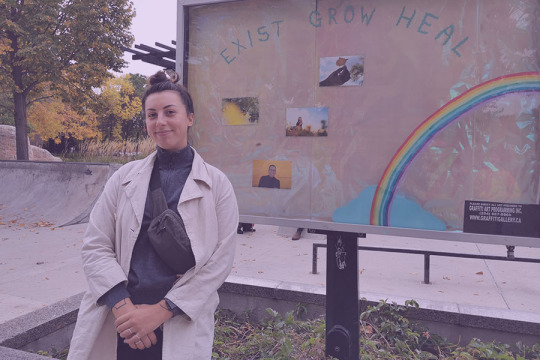
My name is Chanelle Lajoie, my pronouns are she/her, I come from here on treaty one territory, commonly known as Winnipeg Manitoba. My role in the project with Lavender Menace was a mentor to Ella in photography. I’ve been making art for as long as I can remember but what stands out most was when I participated in the youth outreach program at Martha Street Studio, and with my line of work, I would encourage participants to engage with Graffiti Art Programming. The medium I am most comfortable to work in is photography., but I’m now exploring filmmaking and I am really excited about that.

My name is Ella Greyeyes, and I go by she/her, I am from Winnipeg and my family is from Pegius. My role is a photographer, being a mentee. I started photography 2 months ago. My favourite art is mostly photography because I like picturing something and taking a photo of it and when other people see it I hope they feel happy inside.
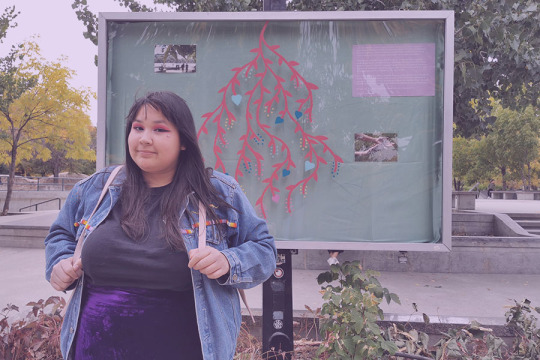
My name is Kiana Compton, I go by she/her. I am Ojibwe, Cree, and Blackfoot. My spirit name is Woman in the Heavens Standing, I work at Art City, I was born and raised in Winnipeg. I was one of the mentors, I mentored Sadie and we did the painting. My uncle, Carl used to babysit me and he lived with me at one point and he would make me do art because he was a painter. And then I was a powwow dancer growing up and we were too poor to buy regalia so my mom got us to make our own. I like painting the best, I used to be a beader but I just feel like painting is more me, it’s chill I like just listening to music and painting whatever I want.
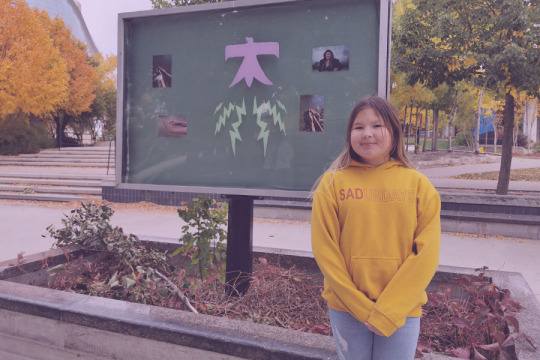
My name is Sadie Hudson-Constant, I go by she/her, my spirit name is Loud Thunderbird Woman. Born and raised in Winnipeg but my family comes from Peguis. I like to sketch a lot. I do a little bit, whenever I can. I like to sew and bead for regalias for my powwow dancing.
Annie: Lavender Menace means so many different things to different people. To each of us individually, we all come together from different upbringings, whether we are beginners, emerging, or semi-established, we have all come together to create something that gives back to our communities. It has resonated with us all differently, so for our artists, what does Lavender Menace mean to you?
Ella: Felt like I was part of the team, I felt like really happy doing this project because I just love taking photos and everybody that worked on this project was just so nice.
Kiana: I guess taking up space that's rightfully meant for us reclaiming space.
Sadie: I don't know it was really cool to be a part of this. This is the first time I got to show my art off.
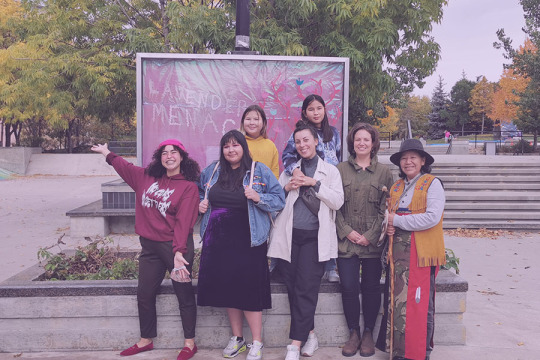
Annie: The group public art exhibition Lavender Menace included a mentorship aspect where two pairs of Indigenous artists would meet at the skatepark, the location of the exhibition, relating that location with being a gathering place for Indigenous and non-Indigenous people alike for millennia. The meaning of secluded intergenerational knowledge-sharing between artists in this not only included skill sharing in the mediums of Photography and Painting but also included nature walks, connecting the artists to each other as well as the land as Indigenous beings.
Knowing the history of this location The Forks of the Red and Assiniboine Rivers, what did it mean for our artists to be gathering, connecting, and making art, here at this location?
Chanelle: I hope that Indigi-queer folks feel regognized on lands that are inherently theirs, and I also hope that folks that do not identity as Idnigenous or Queer recognize its meant to offer space to indviduals who have been underrepresented for most of their lives here. I hope that when people are engaging with the artwork, settling into having conversations that might be challenging and understanding that those challenging conversations may mean we have to give space to these people who are on display.
Ella: I hope they feel happy inside and happy wherever they go.
Kiana: I hope they know the roots of it and that its Indigenous, Indigo-queer, and that it makes this space more inclusive to all.
Sadie: I hope they know what the Thunderbirds do, I know there are people who don’t know but it’d be really cool if they could kind of get an idea.
Annie: Yeah, and what is the idea that your Thunderbird says?
Sadie: Everytime it rains, especially around this time, it’s the time when Thunderbirds are giving Mother Earth water to heal her, so it’s not a bad thing to get those storms.

Annie: The mentorship aspect of this exhibition project played such a huge role, for all of us, learning from each other in new experiences, in new ways, and under new circumstances with social distancing. What did our artists learn from this project that they hope to apply in the future?
Chanelle: I think the number one thing that stood out to me was that the ways in which intergenerational knowledge sharing can also be a creative endeavor. I learned a lot from Ella in our mentorship as a mentor, I think I was also in the position of a mentee, and I think it’s important that we recognize and celebrate all of the important teachings that youth carry with them because they are our future and I look forward to what Ella has ahead of her.
Ella: It was mostly learning photography and both, learning to be on a team with you guys, and doing this photography thing.
Kiana: Being a mentor, usually I’m not going out there and doing my thing with the intention of being a mentor, but it is what it is. As a young person, you are going to be a mentor to other young people because they are always looking up to you and doing what you do so I guess realizing that role and continuing it.
Sadie: I learned not to be scared to go to things like this, it took away some of the anxiety I have to meet new people, so it helped me a lot.
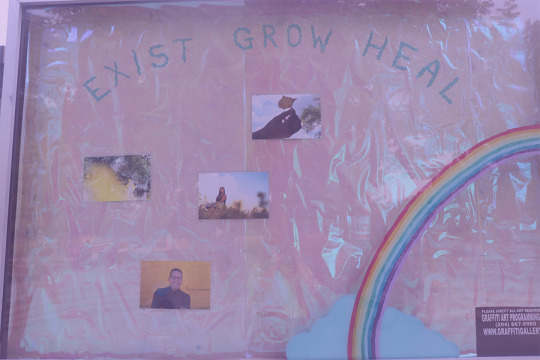
Annie: The show focused on creating an environment to allow Indigi-queer, Two-Spirit, non-binary, femme, queer individuals to thrive, to gather as community, and to take up space, in a space that has always been ours. Lajoie said the show at The Forks is meant to start a conversation about representation of Indigenous LGBT and Two-Spirit people in a space so deeply rooted in Indigenous histories.
In line with the fall solstice, the opening event of Lavender Menace took place September 20, 2020 from 5-7 at The Forks Skatepark. It was an outdoor distanced event with Queer Skate Wpg and Board Broads invited to skate. We had the Gago Brothers B-Boy Dance crew. Kilusan, Maribeth, and Tessa Chartrand as DJs, our DJ set included a live Instagram feed on Graffiti Art Programming’s Instagram account, and encouraged those who were staying home to be a part of the celebrations to encourage healthy communities. It was an open skate, participants and guest got to bring their boards, bike, blades, as well as mask, and be together to recognize and celebrate each other through art.
#Art#PublicArt#StreetArt#GraffitiArt#Indigenous#FirstNations#Metis#Healing#Indigiqueer#TwoSpirit#LGBT#Queer
4 notes
·
View notes